|
|
|
|
|
| |
Quality general dental care with an emphasis on natural esthetics, form and function. Experience with complex restorative, prosthetic and implant treatment.
----------------------------------------------------------------------------------------
DENTAL IMPLANTS:
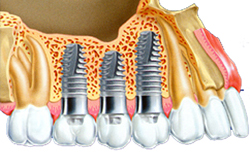
An Overview: What are dental implants?
The jaws are composed of alveolar bone which supports the teeth and cortical bone that lies below. Alveolar bone's sole purpose is to support teeth. When the teeth are lost the alveolar bone shrinks (resorbs) leaving less support to stabilize a denture. Studies have shown that patients can lose 5mm of bone during the first few years after the tooth is lost and this continues throughout the remaining years. As individuals, we all resorb at different rates and some patients may suffer severe bone atrophy leaving a flat ridge that is unable to retain a denture without it floating. Associated with this, the Maxillary sinus enlarges as we age and may create paper thin bone in the upper jaw. Osseous (bone) grafting can be used to raise the floor of the sinus and create adequate support to place root form implants. In the lower jaw as the bone resorbs, the inferior alveolar nerve, a large nerve running through the Mandible may interferr with implant placement. To circumvent this problem, the inferior alveolar nerve can be repositioned to allow implant placement.
Implants are contructed of titanium or titanium alloy. Extensive studies have demonstrated that titanium is completely biocompatible, causes no allergic reactions and is completely accepted by the body. During the fabrication of the implant, an oxide layer forms on the titanium surface upon which the bone will fuse (osseointegrate). Additionally, the surface of the titanium can be treated with hydroxyappatite or sprayed with titanium (TPS) to improve the osseointegration.
Dental implants are divided in two categories based on whether they are placed within the bone (Endosseous) or on top of the bone (Subperiosteal).
Endosseous implants are placed within the bone and are subdivided into two groups; root form and blade form. These type of implants are placed to secure either single crowns, fixed bridges or to retain removable prosthesis (dentures).
Root form implants are cylindrical in shape and are available in various widths (3.2mm to 7mm) and lengths (10mm to 18mm) to accommadate varying amounts of available bone. This type of implant requires adequate width as well as depth of bone to provide a secure foundation. This implant form has been used in its current form since 1970 for treatment of edentulous jaws. Variations of the root form design date back into the late 1800's with clinical success.
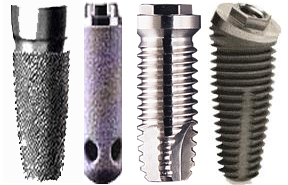
Blade form implants, also known as plate form, are flatter in appearance and are utilized when there is insufficent width of bone but adequate depth is present. They are available in various shapes to fit in and around anatomical structures such as the maxillary sinus and inferior alveolar nerve. Blade implants have been used to treat endentulous jaws since 1960.
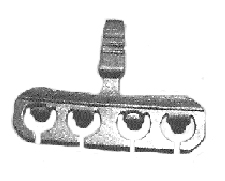
The other main category of implant type are Subperiosteal implants, which lay on top of the bone below the gum tissue and have posts that project through the gun tissue into the oral cavity. These are custom fabricated implants that are made from an impression of the patients jaw bone. Ball attachments or other retaining device are placed on the posts that project through the gum tissue and are used to retain a removable prosthesis (denture). Subperiosteal implants are utilized when insufficient bone is present to accommadate either a root form or a blade implant and anatomical structures limit endosseous implant placement.
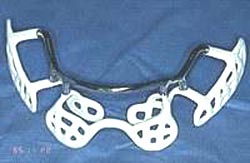
An alternative treatment for the severely resorbed mandible is the ramus frame implant. This is a cross between a subperiosteal and a plate form implant and is designed to engage the posterior ramus bilaterally and the anterior symphasis when anatomic features permit placement. The ramus frame implant is a prefabricated implant that is bent to fit the mandible. The portion shown that has openings is within the bone and a bar secures the denture. This implant has been used in treatment of the resorbed mandible since 1970 and has shown long term success.
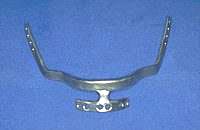
What can be done to create bone that has resorbed so that implants can be placed?
When insufficent bone is unavailable to place endosseous implants, bone augmentation can be performed to create adequate height or width of bone.
When teeth are lost in the posterior upper jaw (maxilla), the maxillary sinus enlarges as the ridge shrinks toward it. This may lead to a ridge with paper thin bone that can not accommadate implant placement and in some cases be inadequate to support a denture over the area.
Grafting procedures can reverse the sinus enlargement and provide sufficient bone to either allow implants to be placed or provide a more stable base to support a removable denture. This procedure is called a sinus lift or sinus augmentation.
As bone resorbs in the anterior upper jaw it shrinks toward the hard palate. This may result in a knife edge ridge that is not wide enough to place a root form implant. A blade implant may be used in this situation or the ridge can be grafted to widen it to allow root form placement. THis is referred to as ridge augmentation.
The posterior lower jaw (mandible) after tooth loss shrinks toward the inferior alveolar nerve that runs through the lower jaw. This may result in minimal bone available above the nerve bundle. This will contraindicate root form implants unless bone can be created to allow implant placement. The nerve can be moved (repositioned) within the bone so that height of available bone is increased. This is referred to as an inferior alveolar nerve repositioning.
Implant Cosmetic Dental Center™
----------------------------------------------------------------------------------------
Dr. Gregori M. Kurtzman is an international lecturer, selected as one of the top 100 dental speakers since 2006 by Dentistry Today, author of over 200 professional articles, a consultant to multiple dental manufacturers for product evaluation, development and research, he provides general dental care in suburban Maryland since 1986.
|
|
|
|
|
|
|
|
|






